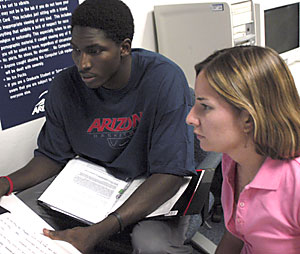 |
|
FILE PHOTO/Arizona Daily Wildcat
|
Men's basketball freshman forward Mohamed Tangara receives a little one-on-one tutoring from psychology graduate student Araceli Hernandez in one of McKale Center's academic facility labs last semester.
|
|
|
By Brett Fera
Arizona Daily Wildcat
Thursday, March 3, 2005
Print this
UA athletics director Jim Livengood said that while he thinks the UA's relatively poor Academic Progress Rate, released earlier this week by the NCAA, is misleading, having athletes and coaches understand what could be at stake is of greater importance.
"Being worried about it is one thing," Livengood said about the UA's 10-place showing for average APR among Pacific 10 Conference schools. "Being aware of it is another."
With an average APR of 916, the UA is one of 16 schools nationally to have at least five teams fall below the benchmark set by the NCAA. A rating of 925, calculated to represent both graduation rates and academic eligibility, is the NCAA's cutoff to determine if sanctions, such as scholarship losses, will be necessary.
Baseball, football, men's outdoor track, women's outdoor track and women's indoor track each missed the cut. Four other UA teams scored under the designated mark, but because of variables such as a small number of members on each team, the NCAA estimates these teams' APRs to be higher than the current findings.
Because the report is preliminary, no penalties will be implemented until next year, when data for two years is available, according to the APR report.
Even so, Livengood said he thinks now is the time to address the issues at hand.
"I think the thing is, right now, it is a shot across the bow," Livengood said. "It's a very, very good warning shot that I guarantee we are paying attention ... to what the consequences are for individual student-athletes and the teams."
Livengood said the UA will use the month allotted by the NCAA to submit inquiries regarding the contents of the APR report.
Livengood will also work with fellow staff, such as associate athletic director Dick Bartcsh, who heads the Commitment to Athletes Total Success program, to alleviate academic issues that are present and can be dealt with in regards to student-athlete academic performance, he said.
With a probable NBA career looming, center Channing Frye of the Arizona men's basketball team, which scored a 957 APR, said it's up to graduating athletes to take it upon themselves to finish out the semester.
"I take a lot of pride in wearing the Arizona uniform," said Frye, an interdisciplinary studies senior.
Frye said that even though his "job interview" with the NBA is around the corner, finishing the semester is of the utmost importance.
"If (not finishing the semester) is going to hurt my team, I'm going to stick around," Frye said.
Frye said he has about one more semester until he earns his degree, and he hopes to finish the credits somehow while playing in the NBA next year and beyond.
Although Frye is not expected to earn his degree this semester, if he stays in good academic standing during the semester the APR won't be negatively affected.
For the Arizona baseball team, which recorded the school's lowest APR rating at 855, the problem goes much deeper than who graduates and who doesn't.
Major League Baseball only allows a player to be drafted either directly out of high school or once the athlete is three years removed from high school.
Arizona baseball head coach Andy Lopez said he estimates that anywhere between five and seven juniors from this season's team will leave once drafted or offered professional contracts, potentially leaving the team in a drastic situation.
"If you have a lot of seniors in your program, you're not doing well on the field," Lopez said, noting that success breeds attention for players during their first three years in college.
While Lopez looks at the attempt to recruit the nation's best players as a catch-22, he said he agrees with the principle of the APR.
"As long as we're all on the same page we'll be fine," he said. "You have to live within the rules you're under."
Arizona women's basketball head coach Joan Bonvicini, whose team was one of three at the UA to score a perfect 1,000 on the APR scale, said she thinks the possibility of players transferring or leaving school early in any sport subjects teams to undeserved penalties.
"For example, we have Joy Hollingsworth on our team," Bonvicini said of the junior transfer, currently sitting out her redshirt season per NCAA rules. "(University of) San Francisco, where she played (before) would get penalized, and I really don't think they necessarily should if (student-athletes) leave in good standing and go to another program."
Bonvicini and Livengood each linked the Arizona football team's recent situation - the program employed three different head coaches last year in a span of months - as another potential concern.
"Having gone through the number of football coaches we have is going to take a toll," Livengood said, referencing how players leave once the coach who recruited them is gone.
Livengood said his department conducted its own research at the same time as the NCAA and produced similar results across the board, except for a few discrepancies.
Livengood said the APR system could likely affect which players coaches recruit, based on the athlete's perceived dedication to staying in school for his or her entire collegiate career.
"Now that sounds very pie in the sky - very idealistic - but it all starts with the beginning of recruiting," Livengood said.
